Book contents
- Frontmatter
- Contents
- Preface
- Acknowledgements
- 1 Introduction
- 2 Stress
- 3 Displacement and strain
- 4 Relation between stress and strain
- 5 Loading of brittle rocks to failure
- 6 Stress concentration
- 7 Theories of brittle failure of rocks
- 8 Extension fractures and shear fractures
- 9 Displacements and driving stresses of fractures
- 10 Toughness and fracture mechanics
- 11 Field analysis of extension fractures
- 12 Field analysis of faults
- 13 Evolution of extension fractures
- 14 Evolution of faults
- 15 Fluid transport in rocks – the basics
- 16 Fluid transport in faults
- 17 Fluid transport in hydrofractures
- Appendix A Units, dimensions, and prefixes
- Appendix B The Greek alphabet
- Appendix C Some mathematical and physical constants
- Appendix D Elastic constants
- Appendix E Properties of some crustal materials
- Index
- References
16 - Fluid transport in faults
Published online by Cambridge University Press: 05 June 2012
- Frontmatter
- Contents
- Preface
- Acknowledgements
- 1 Introduction
- 2 Stress
- 3 Displacement and strain
- 4 Relation between stress and strain
- 5 Loading of brittle rocks to failure
- 6 Stress concentration
- 7 Theories of brittle failure of rocks
- 8 Extension fractures and shear fractures
- 9 Displacements and driving stresses of fractures
- 10 Toughness and fracture mechanics
- 11 Field analysis of extension fractures
- 12 Field analysis of faults
- 13 Evolution of extension fractures
- 14 Evolution of faults
- 15 Fluid transport in rocks – the basics
- 16 Fluid transport in faults
- 17 Fluid transport in hydrofractures
- Appendix A Units, dimensions, and prefixes
- Appendix B The Greek alphabet
- Appendix C Some mathematical and physical constants
- Appendix D Elastic constants
- Appendix E Properties of some crustal materials
- Index
- References
Summary
Aims
The way active faults transport crustal fluids is important in many fields of earth sciences, including petroleum geology, geothermal research, volcanology, seismology, and hydrogeology. There is increasing evidence that active, or potentially active, faults largely control fluid flow in solid rocks. In order to understand the flow of ground water and other crustal fluids in a region, it is necessary to know the general permeability structure of the fault zones in that region. This follows because the general hydromechanical structure of a fault zone, in relation to that of the host rock, determines whether the fault zone acts as a conduit that transports fluids or as a barrier to fluid flow. Here the focus is on the effects of faults on ground-water flow, but the results are, with suitable modifications, applicable to the transport of other crustal fluids. The principal aims of this chapter are to:
Explain how fluids migrate to fault zones, in particular active fault zones.
Present a general model on fluid transport along a fault zone.
Explain the effects of fluid pressure on the apertures of fractures in the damage zone.
Provide a simple model of fluid transport along the fault damage zone.
Provide a simple model of fluid transport along the fault core.
Discuss the general implications of the results for fluid transport by faults.
- Type
- Chapter
- Information
- Rock Fractures in Geological Processes , pp. 496 - 524Publisher: Cambridge University PressPrint publication year: 2011



